
Fort Sumter is a sea fort built on an artificial island protecting Charleston, South Carolina from naval invasion. Its origin dates to the War of 1812 when the British invaded Washington by sea. It was still incomplete in 1861 when the Battle of Fort Sumter began the American Civil War. It was severely damaged during the war, left in ruins, and although there was some rebuilding, the fort as conceived was never completed.

The Battle of Fort Sumter was the bombardment of Fort Sumter near Charleston, South Carolina by the South Carolina militia. It ended with the surrender by the United States Army, beginning the American Civil War.

The flag of South Carolina is a symbol of the U.S. state of South Carolina consisting of a blue field with a white palmetto tree and white crescent. Roots of this design have existed in some form since 1775, being based on one of the first Revolutionary War flags. While keeping most of its design intact since its adoption, it has varied over the years.

Fort Sumter and Fort Moultrie National Historical Park is a United States National Historical Park located in Charleston County, in coastal South Carolina. It mainly protects Fort Sumter, Fort Moultrie, the Charleston Light and Liberty Square, Charleston. It was known as Fort Sumter National Monument until it was renamed in the John D. Dingell Jr. Conservation, Management, and Recreation Act, signed March 12, 2019.
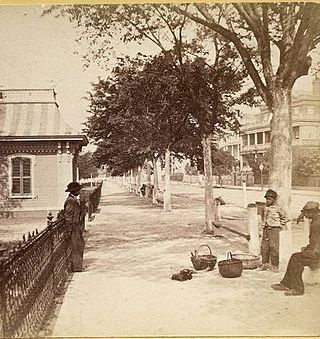
White Point Garden is a 5.7 acre public park located in peninsular Charleston, South Carolina, at the tip of the peninsula. It is the southern terminus for the Battery, a defensive seawall and promenade. It is bounded by East Battery, Murray Blvd., King St., and South Battery.
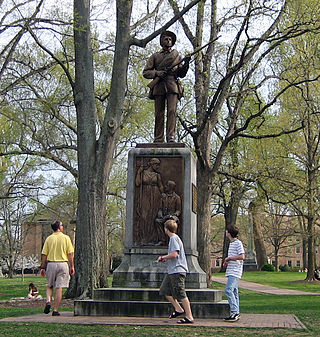
The Confederate Monument, University of North Carolina, commonly known as Silent Sam, is a bronze statue of a Confederate soldier by Canadian sculptor John A. Wilson, which once stood on McCorkle Place of the University of North Carolina at Chapel Hill (UNC) from 1913 until it was pulled down by protestors on August 20, 2018. Its former location has been described as "the front door" of the university and "a position of honor".
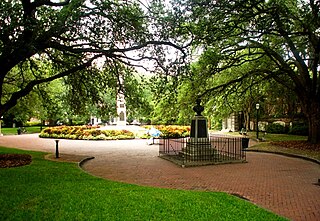
Washington Square is a park in downtown Charleston, South Carolina. It is located behind City Hall at the corner of Meeting Street and Broad Street in the Charleston Historic District. The planting beds and red brick walks were installed in April 1881. It was known as City Hall Park until October 19, 1881, when it was renamed in honor of George Washington. The new name was painted over the gates in December 1881.

Marion Square is greenspace in downtown Charleston, South Carolina, spanning six and one half acres. The square was established as a parade ground for the state arsenal under construction on the north side of the square. It is best known as the former Citadel Green because The Citadel occupied the arsenal from 1843 until 1922, when the Citadel moved to the city's west side. Marion Square was named in honor of Francis Marion.

Joseph Patrick Riley Jr. is an American politician who was the Mayor of Charleston, South Carolina. He was one of the longest serving mayors in the United States that is still living, having served 10 terms starting on December 15, 1975, and ending on January 11, 2016.

The South Carolina State House is the building housing the government of the U.S. state of South Carolina, which includes the South Carolina General Assembly and the offices of the Governor and Lieutenant Governor of South Carolina. Located in the capital city of Columbia near the corner of Gervais and Assembly Streets, the building also housed the Supreme Court until 1971.
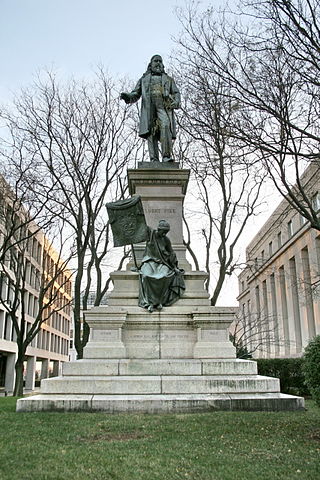
The Albert Pike Memorial is a public artwork in Washington, D.C. honoring Albert Pike (1809–1891), a senior officer of the Confederate States Army as well as a poet, lawyer, and influential figure in the Scottish Rite of freemasonry. The memorial, which now only includes the base and Goddess of Masonry sculpture, is sited near the corner of 3rd and D Streets NW in the Judiciary Square neighborhood. The memorial's two bronze figures were sculpted by Gaetano Trentanove, an Italian-American artist responsible for another Washington, D.C. sculptural landmark, the Daniel Webster Memorial. The dedication ceremony in 1901 was attended by thousands of Masons who marched in a celebratory parade.

Although the Confederate States of America dissolved at the end of the American Civil War (1861–1865), its battle flag continues to receive modern display. The modern display began during the 1948 United States presidential election when it was used by the Dixiecrats, a political party that opposed civil rights for African Americans. Further display of the flag was a response to the civil rights movement and the passage of federal civil rights laws in the 1950s and 1960s.

John J. Tecklenburg is an American businessman and politician. He is the current Mayor of Charleston, South Carolina. He was sworn in on January 11, 2016.
More than 100 monuments and memorials to the Confederate States of America and associated figures have been removed, all but five since 2015. Some have been removed by state and local governments; others have been torn down by protestors.
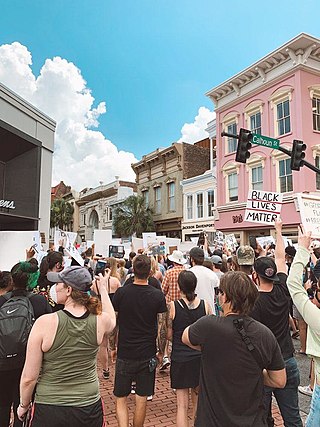
This is a list of protests in South Carolina related to the murder of George Floyd.

John Caldwell Calhoun was a Democrat, statesman and politician from Abbeville, South Carolina. Calhoun served within several positions inside state and federal governments. He is most notably remembered for his tenure as vice president from 1825 to 1832, serving under both John Quincy Adams and Andrew Jackson from 1825 to 1832. Calhoun was known was for his staunch defense of slavery inside the United States. He led the pro-slavery faction inside the Senate, fighting against abolition and wanted to expand slavery westward in the United States. Calhoun's most infamous words in his political career was in defense of slavery. Many southern politicians excused slavery as a "necessary evil"; however, in a speech on the Senate floor on February 6, 1837, Calhoun defended slavery as a "positive good." On March 31, 1850, John C. Calhoun died of tuberculosis at the Old Brick Capitol boarding house in Washington, D.C.
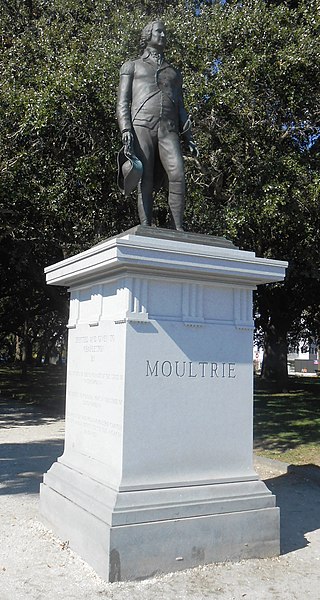
The William Moultrie statue is a monumental statue in Charleston, South Carolina, United States. Located in White Point Garden, the statue was unveiled in 2007 and honors William Moultrie, a general in the American Revolutionary War.

The Denmark Vesey Monument is a monumental statue in Charleston, South Carolina, United States. The monument was erected in 2014 in Hampton Park and honors Denmark Vesey, a freedman who lived in Charleston and was executed in 1822 for plotting a slave revolt. It was designed by American sculptor Ed Dwight.


















